April in Japan: Following Elephants
It is believed that the Buddha was born on the 8th day of the 4th lunar month. The observances in Japan are called Hana-matsuri, 花祭, Flower-festival, and Kan-butsu-e, 灌仏会, Bathe-buddha-meeting. The year 2023 contained a lunar 2nd leap month, which was added. April 20, is when the 3rd lunar month began. The Buddha’s lunar birthday on the 8th day of the 4th lunar month which, in 2023, is on May 27th.
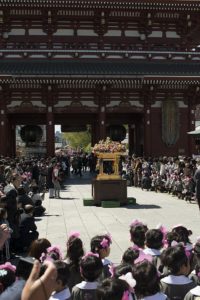
On the 8th day of lunar 4th month, which is believed to be the date of the birth of the Buddha, Sha-ka Tan-jo-butsu, 釈迦誕生佛, Explain-(sound) Birth-live-buddha, a rite called Kan-butsu-e, 灌仏会, Libate-buddha-meeting is observed. It is more familiarly called Hana Matsuri, 花祭, Flower Festival. The flower is the lotus, which is sacred to Buddhism. The hanamidō is often placed on the back of a great white elephant, which is also the vehicle of Fugen Bosatsu, the Buddhist protector of the 4th month.
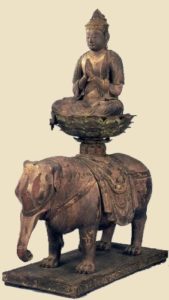
Fugen, who originated in India as Samantabhadra Bodhisattva, is the protector of Buddhism, and is known as the God of Praxis. Some believe that Fugen is a manifestation of Kan-non, 観音, See-sound, Buddhist goddess of mercy, and who also at times is depicted riding on the Hakuzō. Fugen’s palms are held together in the mudra of Ga-sshō 合掌, Gather-hands. He made ten vows of practice and faith, is all-pervading goodness, protector of those who teach the Buddhist law, rides the elephant, Airavata, which is also the vehicle of Taishakuten/Indra. Fugen presides over the memorial service held on the 28th day following one’s death and is associated with Go-kan-ō, 五官王, Five-govern-king, the fourth judge of Ten Hell Judges. The Go-kan are also identified as the five sense organs; ears, eyes, mouth, nose, and tongue.
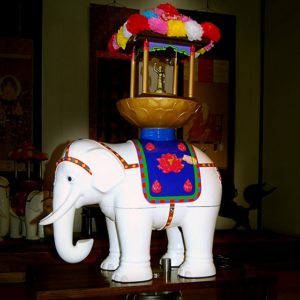
There is an interesting wordplay on zō, 象, elephant, and 像, figure, so that the word Shaka-zō means both figure and elephant. Such display elephants are made in a great range of sizes from very small to gigantic.
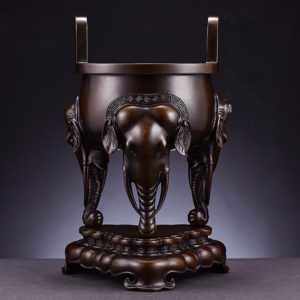
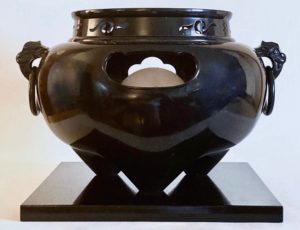
Left: Chinese bronze incense burner in the form of three elephant heads balancing on the tips of their trunks; wood base. A ‘Greek-key’ pattern borrowed from lightning bolt pattern from India. The concept connects elephants with incense and fire, as well as water which elephants love. The incense burner influenced the form of the furo of Chanoyu. Right: bronze ki-men bu-ro, 鬼面風炉, demon-face wind-hearth, on wood shiki-ita, 敷板, spread-board, Japan. The shape of the tapered feet of the pictured furo is chichi-ashi, 乳足, teat-foot. It is curious to note that in the beginning of the Hindu / Buddhist world, the Haku–zō/White elephant was created in the churning of the Milk Ocean, the Milky Way.
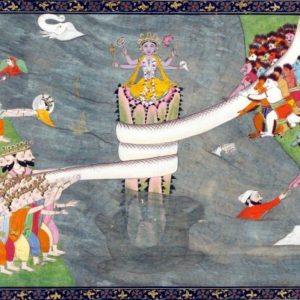
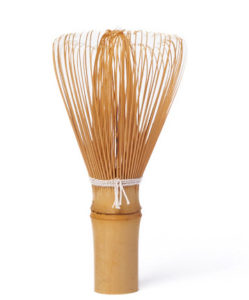
Left: painting of the ‘Churning of the Ocean of Milk’, India; the great white snake wrapped three times around Mt. Sumeru, gods on the left, demi-gods on the right, the 6-tusk white elephant Airavata pictured in the upper left. According to Hindu belief, Airavata comes from the word ‘iravat’ meaning ‘Child of Water’. Right: cha-sen, 茶筅, tea-whisk, bamboo with white thread wrapped three times around the whisk.
Names of ma-tcha, 抹茶, powder-tea, for usu-cha, 薄茶, thin-tea, often include the word ‘white’, haku, 白; such as Kan-no-shiro, 関の白, Barrier-’s-white, of I-ppō-dō. 一保堂, One-provision-hall. Usucha is whisked briskly so that the tea becomes frothy, somewhat white.
Fugen’s great white elephant, Airavata, is variously depicted as a typical elephant, at times with three heads, or as three elephants. Some images of Fugen depict the elephant holding a lotus flower with the end of his trunk.
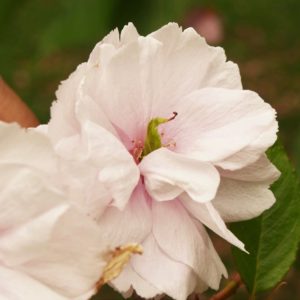
Fugen Bosatsu appears in both the Ryō-kai-man-da-ra, 両界曼荼羅, Both-worlds-wide-weed-spread, Tai-zō-kai Man-da-ra, 胎蔵界曼荼羅, Womb-keep-world Wide-weed-spread, Kon-gō-kai Man-da-ra, 金剛界曼荼羅, Gold-strength-world Wide-weed-spread. In the Taizōkai mandala, Fugen is positioned in the central Eight-Petal Court, Chū-dai-hachi-yō-in, 中台八葉院, with left hand grasping a lotus surmounted with a sword, and also in the Monju-in, 文殊院, Monju Court, with left hand holding a lotus topped with a three-pronged vajra, ko-sho, 鈷杵, cobalt-pestle.
In ancient India, there was a metal weapon called a vajra, that became a symbol of spiritual power in Hinduism and Buddhism. It represents the lightning bolt of Indra, king of the gods – in Japanese, Tai-shaku-ten, 帝釈天, Emperor-explain-heaven (deva), with which he brought the world into existence.
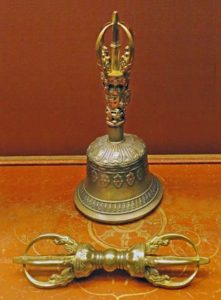
The Sanskrit vajra, in Japanese is a collectively called, kon-gō-sho, 金剛杵, gold-strength-pestle ko-sho, 鈷杵, cobalt-pestle; single bolt with points at both ends. Other types include, san-ko-sho, 三鈷杵, three-cobalt-pestle, with a point at both ends flanked by curved ‘talons’; go-ko-sho, 五鈷杵, five-cobalt-pestle, with pointed ends surrounded by four ‘talons’; and an X-form with flat sankosho at each end. Another vajra has a point and talons at one end, and a bell at the opposite end; kon-gō-rei, 金剛鈴, gold-strength-bell.
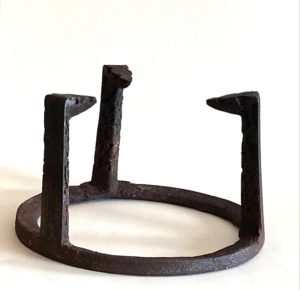
There may be a strong connection between the sankosho and the gotoku that supports a kettle in Chanoyu. In the months of the March and April, the gotoku, pictured above, is not placed in the ro: the kettle may be suspended from the ceiling, or its flange placed on blocks of wood on the foundation of the hearth. Rikyū wished one to use a gotoku futa-oki, 蓋置, lid-place, when the gotoku is not used in the hearth.
It might be that this three-pronged kosho represents the gotoku, and therefore, Fugen is holding it, and so that it is not in the hearth. Fugen can appear in two different forms – as a two-armed deity holding a five-pronged vajra in right hand and a bell, kon-gō-rei, 金剛鈴, gold-strength-bell, in the left while sitting atop a lotus supported by three elephants, or by a single three-headed elephant.
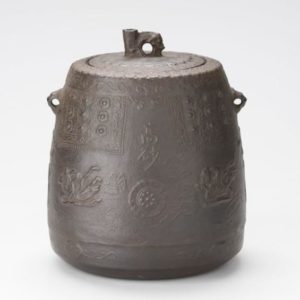
The kongōrei bell is held in the hand, and its function is to ring, and therefore is held in the air, like the tsuri-kama, 釣釜, hanging kettle. This particular kind of bell has a clapper, rather than the temple bell which has no clapper, but is struck on the outside to produce the sound. The temple bell is called a tsuri-gane, 釣鐘, suspend-bell, and has been the inspiration for creating a kettle for Chanoyu. The bell is suspended by a single lug on the top, while a kettle must have a lid on the top, so that it is hung from two lugs, kan-tsuki, 鐶付, metal ring-attach, on either side of the kettle. .
In Buddhism, the directions are identified with various aspects including the lotus, hasu, 蓮, and the southeast direction is identified with the Utpara Lotus, the Shō-ren, 青蓮, Blue Lotus. The Blue Lotus in Buddhism is the symbol of the victory of the spirit over the senses, of intelligence and wisdom, of knowledge. It is generally represented as a partially opened bud, whose center is unseen, the embodiment of the ‘perfection of wisdom’. These attributes can be ascribed to Fugen, who is located in the southeast. Fugen is often depicted holding a lotus bud (at times a blue lotus) on a long stem, hence, Fugen may be identified with the Blue Lotus. The Blue Lotus is actuality a waterlily, but is depicted as a lotus. The Blue Lotus has been a source of medicine for thousands of years wherever it grows, among the earliest records is in ancient Egypt.
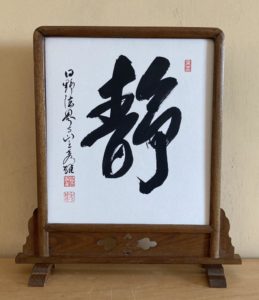
There is another word that is read fu-gen, 不言, no-word, that means silence. Zen, as in many faiths, advocates silence. When a person who enters a Tearoom crawling through the nijiri-guchi, which is ideally located in the southeast corner of a room, the remembrance of the name of Fugen, may evoke the concept of fugen that means silence. One must be silent when entering any Tearoom, regardless of the actual location of the entrance.
Fugen Bosatsu is the guardian of the southeast, and is the protector of the sign of the Tatsu-Mi, 辰巳, Dragon-Snake. Tatsu-Mi is also written 巽, which also means obedient. The Kanji includes 2 Kanji for Mi, 巳. The sign of Mi is in accord with the 4th lunar month, the location of the nijiri-guchi, 躙口, crawl in-opening, of the Tearoom.
The width of the opening of Rikyū’s nijiri-guchi is H. 2.1 x W. 2.25 shaku kane-jaku. H. 2.2 x 2.1 shaku kane-jaku. Myō-ki-an Tai-an, 妙喜庵待庵; H. 2/61 x 2.36 shaku kane-jaku. Which is almost the entire width of the wall of the Tearoom and the sign of Mi, is 3.0 shaku kane-jaku.
According to tradition, the Buddha was born on the 8th day of the 4th lunar month, in Lumbini located in the Terai plains of southern Nepal. According to the adjusted dating from lunar to solar calendar, it was on 26 April 624/623 BC, at 11:55:48 am. This is not my calculation, but calling it ‘noon’ will suffice. Noon in Japanese is Shō-go, 正午, Right-horse. The period of time protected by Fugen is in the sign of Mi, the Snake. The middle of the ‘hour’ of the Snake is Shō-go, 正巳, Right-snake, 10 am. This moment in time is identified with the sign of the Snake.
The ‘hour’ of the Snake, Mi-no-koku, 巳の刻, Snake-’s-time, is from 9 to 11 am. The Kanji for mi, 巳, originally meant ‘stop’. Its origin denoted the moon’s ‘coming forth’ stage, the early waning gibbous phase. The attachment of the association with the snake was added somewhat arbitrarily later.
A Buddhist has meal called o-toki, お斎, hon.-abstain, twice a day, except that one should not eat food after noon, but wait until the meal of the following morning.
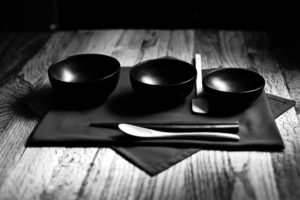
Eisai, who brought Tea and Zen from China in 1191, recorded his Zen experience in China when he was 28 years old. “When the sun goes down, we offer lanterns, tō-ka, 灯火, lamp-fire, and worship. He sat in meditation when people were asleep. Children go to bed at midnight. At the time of the Tora/Tiger (4:00 a.m.) Zazen. At the time of the U/Hare (6:00 a.m.), offer a lantern and worship. At the time of Ten-mei, 天明, dawn, eat rice porridge. At the time of the Tatsu/Dragon (8:00 a.m.) sutras are read, studied, and the elder preached. At the time of the Mi/Snake, Mi-no-koku, 巳の刻, (10:00 a.m.) Zazen. At the time of the Ume/Horse, 12 noon, eat food/rice. At the time of Hitsuji/Ram, (2:00 p.m.) the body is purified with water. At the time of the Saru/Monkey (4:00 p.m.) Zazen.
According to the record of Eisai, Mi-no-koku, 巳の刻, (10:00 a.m.), the ‘hour’ of the Snake, was one of the times for Zazen. This time is found at the nijiri-guchi of the ideal yojōhan chashitsu of Sen no Rikyū. Eisai’s ‘hour’ of the Ume/Horse, Shō-go, 正午, Correct-horse, 12 noon, was the time to eat food/rice, which is the same as the Shō-go Cha-ji, 正午茶事, Correct-horse Tea-matter. Therefore, when one enters the Tearoom through the nijiri-guchi, one enters a Zen-dō,禅堂, Zen-hall.
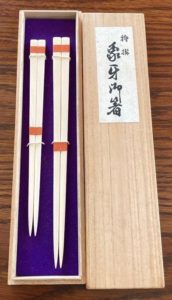
Although ivory hashi are not used of Chanoyu food service, they are part of daily Japanese life. When eating food in the Tearoom, sugi-bashi, 杉箸, cedar-rods, are used, and ao-bashi, 青竹箸, green-rods, or take-bashi, 竹箸, bamboo-roods, are used to serve food. The hashi used in Chanoyu are ultimately disposable, whereas hashi of other materials such as ivory, and wood, are relatively permanent and reusable.
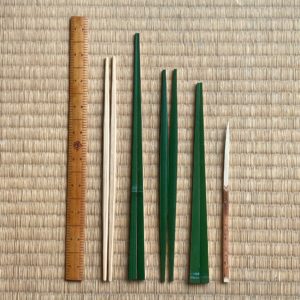
From Left: kane-jaku mono-sashi, 曲尺物差, bend-span thing-distinguish, take, 竹, bamboo; ryō-boso, 両細, both-taper, sugi, 杉, cedar; ao–bashi, 青箸, green(bamboo)-rods: naka–bushi, 中節, middle-node, ryō-boso, 両細, both-taper, moto-bushi, 両細, origin-node; kuro-mo-ji, 黒文字, black-letter-character.
Hashi were originally made of bamboo, take, 竹, and the Kanji for bamboo, ⺮, is part of the Kanji for hashi, 箸.
In very formal Tea presentations, 7 different kinds of sweets, お菓子, are served to each guest, together with a 6 sun kane-jaku, kuromoji and a 6 sun aka-sugi bashi, 赤杉箸, red-cedar rods. Together, they manifest the auspicious kō haku, 紅白, red and white. Hakuzō, Airavata had 6 tusks. After eating 7 sweets, the aka-sugi bashi is broken like Hakuzō’s right tusk that was thrown at the moon. The elephant’s tusk spears lifts, digs, scrapes bark off trees, elephants are vegetarians. Another word for tusk is kiba.
It is good for each person at a Tea gathering to bring their own pick with which to eat their sweet. The general term for the pick is yō-ji, 楊枝, willow-branch, as it was made of beneficial willow wood. A toothpick is an essential item owned by a Buddhist monk.
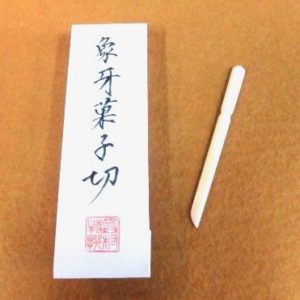
The are many ways to enjoy Chanoyu regardless of one’s belief. Food is the universal requirement for life, together with water. Many people believe in the care needed to raise crops and prepare meals directly from nature, which is at the heart of Buddhism and Shintō, among many other faiths. Cha and Zen have but one taste is an ancient concept, and in Japan, animals provide much of the food. However, Buddhists are reputed to take no life to sustain one’s own life. In the most formal Tea presentation, the meal is entirely vegetarian. Some vegetarians, try to image they are eating a hamburger when the paddy is made of beans. It is not a burger. But what is in that mind to be a part of the world and yet not. How we perceive life needs education, and to see the greater picture. When we enter the quiet, fragrant world of faith and food and Tea, we need to leave our known world outside, and to find a new way. The small opening of the nijiri-guchi prevents our entering with the trappings of discord, and to humble ourselves, to be in harmony with each other, and to try to see a new world in the old. Be open to new things.
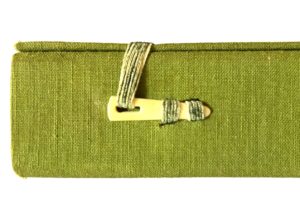
In Zen, there is a famous ancient tale of not seeing the whole picture. The ancient tale of perception is told in variations of Roku-nin no mō-jin to zō, 六人の盲人と象, Six-persons ’s blind-person and elephant. Each person blind man identifies the part of the elephant that he touches, which ultimately does not acknowledge that it is an elephant. Disagreement leads to fighting. Specifics vary, but one source gives the following details.
First man touched the hana, 鼻, trunk, and thought it was a hebi, 蛇, snake.
Second man touched the mimi, 耳, ear, and thought it was an uchiwa, 団扇, round-fan.
Third man touched the ashi, 足, leg, and thought it was a ki-miki, 木幹, tree-trunk.
Fourth man touched the dō-tai, 胴体, body-torso, and thought it was a kabe, 壁, wall.
Fifth man touched the shi-ppō, 尻尾, bottom-tail, and thought it was a nawa, 縄, rope.
Sixth man touched the kiba, 牙, tusk, and thought it was a yari, 槍, spear.
Another group of features: head – pot; ear – winnow; tusk – plowshare; trunk – granary; foot – pillar; back – mortar; tail – brush.
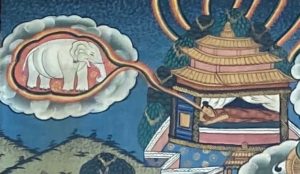
Queen Maya, the mother of Buddha, was bathed by elephants: Hana-mi-dō, 花御堂, flower-hon.-hall, square edicule four posts with canopy roof, placed often on the back of a sculpted image of the white elephant Airavata.
Airavata, the great white elephant, appeared in a dream of Queen Maya, and later she gave birth to the Buddha. It may be assumed that Airavata was present at the birth of the baby Gautama, who became the Buddha.
One night, the Queen dreamt of a magnificent white elephant, Roku-ge no Byaku-zō, 六牙の白象, Six-tusk ’s White-elephant, also called Haku-zō, 白象, White-elephant. In some accounts, the elephant is Airavata, the vehicle of many Hindu and Buddhist deities. The elephant came towards her carrying a white lotus flower and entered her side. In one account, one of his six tusks penetrated her right side. At his birth, the baby Gautama emerged from her right sleeve, and took seven steps and where a lotus appeared to support his feet.
Lumbini was a little garden paradise, with carpets of flowers, humming bees, and chirping birds. The expectant Queen wandered around, enjoying the tranquility. As she passed under the tallest Sal Tree, she felt her labor pains, and she knew that her time had come. She held onto a branch of the tree, and gave birth while standing up. At that moment, four angels caught her baby, the Future Buddha, in a golden net. The four corner posts of the Tearoom. Shi-ten-nō, 四天王, Four-heaven-kings, and Ryū-sei-kyū-shi, 竜生九子, Dragon-born-nine-child, the nine sons of the Dragon King of the sea.
Nine Dragon Kings caused sweet rain to fall, which was the origin of the Kan-butsu-e, 灌仏会, Libate-buddha-meeting. The number 8 means that the ‘it’ came from all sides.
Queen Maya’s Sal tree where she gave birth to the Buddha, may be represented by the toko-bashira, 床柱, floor-post. The Kanji for hashira, 柱, is composed of ki, 木, tree, and shu, 主, master. The Kanji is used to numerate deities. It should be noted that the Kanji for toko, 床, also means bed. The original Kanji, 牀, is composed of hidari-gata, 爿, left-side, and ki, 木, tree, beside a tree. In India, a luxurious bed may be decorated with ivory, and called a zō-shō, 象床, (elephant) ivory-bed.
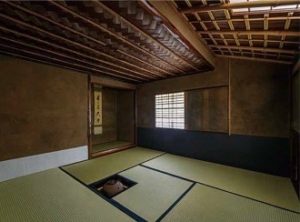
The yo-jō-han, 四畳半, four-mat-half, Tearoom may be a symbolic identification with an elephant. The four hashira, 柱, posts, like the legs of an elephant. The tokobashira is made from the trunk of a tree, and although there is no such wordplay between the trunk of a tree and the trunk of an elephant, the toko-bashira may represent the trunk of an elephant. Flowers may be displayed in a hana-ire hung on a hook on the toko-bashira, might evoke the flower held by the trunk of the elephant that gave it to the Buddha. The tokonoma could represent the hana-mi-dō, 花御堂, flower-hon.-hall, of the birth of the Buddha.
One of signal events in the history of Buddhism is when the Buddha was choosing his successor to lead the sangha, he held up a flower and twirled it in the air. One of his closest followers, Ananda, smiled, and the Buddha handed him the flower, thus bestowing leadership, like a parent. This incident follows an earlier event, when Devadatta, the envious cousin of the Buddha, attempted to kill him. Devadatta tried to have the ferocious elephant, Nalagiri, attack and kill the Buddha. On a trumpeting rampage, Nalagiri approached the Buddha who calmed the elephant’s spirit. With his trunk, Nalagiri took a flower from the hair of a woman in the crowd, and humbly bowing, gave it to the Buddha.
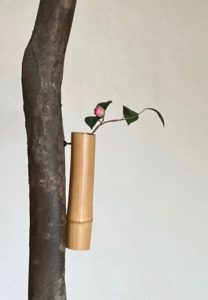
The ideal hanaire for cha-bana, 茶花, tea-flower, according to Rikyū, is a length of bamboo filled with water for a flower. Bamboo and elephant. Rikyū’s renown bamboo flower containers each have a hole in the back so that they be hung on a hook. There are two hooks in the tokonoma that hold flower container: one in the center of the back wall, and one in the toko-bashira.


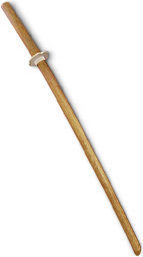
Left: toko-bashira, 床柱, floor-post, sugi, 杉, cedar, with hana-ori-kugi, 花折釘, flower-fold-hood. Rikyū wrote that the hana-ori-kugi is driven into the toko-bashira above the floor about san-jaku san-zu go-bu, 三尺三寸五分, three-‘foot’ three-‘inch’ five-division, 40 inches.
Hana-kugi, 花釘, flower-hook, also hana-ori-kugi, 花折釘, flower-fold-hook, blackened steel; sizes vary – L. 3 sun kane-jaku. Some hooks are nails, while others are screws.
Boku-tō, 木刀, wood-sword, shira–kashi, 白樫, white-oak, wood, leather tsuba, 鍔, guard, for practice; L. 三尺三寸五分, 33.5 shaku kane-jaku, 100cm, handle L. 8 sun kane-jaku. Both the sword and hook have a similar feature: the sword has a tsuba and the hook has an escutcheon.
The hana-kugi is one the east side of the toko-bashira, directed toward the general area of the hanging scroll and flowers, etc. In its way, the toko-bashira, as its name indicates, is more a part of the tokonoma than the Tearoom. Identifying the back wall of the tokonoma with the east, the toko-bashira is identified with the northwest and autumn. The post in the back left corner of the tokonoma is identified with the northeast and spring, and is where the budding willow branch is displayed for the New Year.
The north direction is identified with Senju Kannon and the toko-bashira of the yojōhan. Kannon is also manifest in Fugen Bosatsu, with a connection with the toko-bashira and the elephant presenting a flower to the Buddha. One of the 33 manifestations of Kannon, is Shō-kan-non, 聖観音, Holy-see-sound, who holds an unopened lotus bud in the left hand near the chest. Shōkannon most closely resembles a human being.
The walls are suna-kabe, 砂壁, sand-wall, which is fragile, so the bottom of the wall is covered with white paper where the teishu moves about and prepares Tea, and black paper where the guests sit. The white paper may evoke the whiteness of the white elephant, Hakuzō, Airavata.
Elephants forage for grasses, their principal diet, as well as bamboo, legumes, bark, palms, and other plants. Elephants toss grasses on their backs for protection from the sun and rain, which may be identified with the grass tatami on the floor of the Tea room, and the straw thatch of the roof.
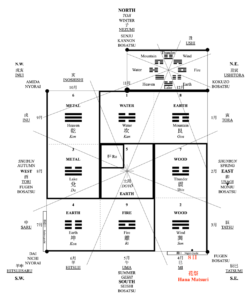
The Buddha’s birthday in Japanese is called Hana Matsuri, 花祭, Flower Festival, which occurs on the 8th day of the 4th lunar month. This corresponds with the ideal location of the nijiri-guchi of the yojōhan chashitsu. One enters the Tearoom on the day of Buddha’s birth. Although this often occurs in Japan when the, sakura, 桜, cherry, trees are in bloom, so that people assume that the hana, of Hana Matsuri, is the cherry blossom. However, the flower is the lotus, hasu, 蓮, on which one is born in Buddhist paradise.
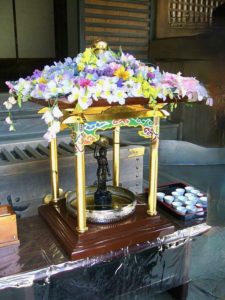
Perhaps the tokonoma represents the hana-mi-dō, 花御堂, flower-hon.-hall. The structure has a raised floor, four posts, and a roof. Flowers are an essential aspect of Chanoyu and at a Tea-gathering, and are displayed in the tokonoma. Flowers may be displayed in a container hana-ire, 花入れ, flower-receptacle, suspended from a hook in the ceiling of the tokonoma. The hook is called a hana hiru-kugi, 花蛭釘, flower leech-hook. Hiru alludes to Ebisu, the son of the primal couple, Izanagi and Izanami. Unable to stand at 3 years of age, his parents set him in a boat adrift on the Ama-no-gawa, 天の川, Heaven-’s-river.
A hook, kugi, 釘, also kagi, 鈎, is a feature also of Ganesha, with which elephants are goaded.
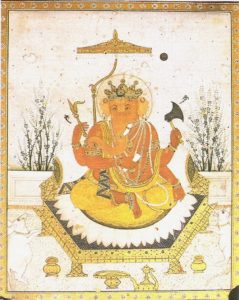
The Kanji for elephant, 象, also means pattern after, imitate, image, shape, sign, etc, and another reading is katadoru. The Japanese word for leg is the same for foot, ashi, 足, which is also read soku, tariru, taru, ta, su, and also means sufficient, and the counter for pairs of footwear. Zō no ashi, 象の足, elephant ’s foot/leg. Zō-ashi, 象足, elephant-foot, Operculicarya pachypus, is a small odd-looking tree, that is a favorite subject for bon-sai, 盆菜, tray-plant.
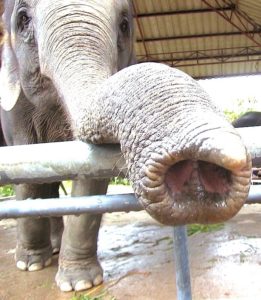
Zō no hana, 象の鼻, elephant ’s nose, is also read zō-bi. The Kanji for hana, 鼻, nose, snout, is also read bi, and is composed of ji, 自, self, and hi, 畀, give. It should be understood that most human beings live by breathing in and out of the nose, which is our chief organ as a manifestation of In and Yō, 陰 陽, negative and positive.
The trunk of Ganesha has three mystical directions with regard to the beginning of the trunk, not the end of the trunk: toward his left is feminine, the moon, and Ida Nadi, nourishing, and calm form of the Deity. His trunk toward his right, is masculine, the sun, Pingala, calls for immense dedication and purity, and it also gives immediate outcomes. In the home one must work on all the rituals and perform proper ceremonies. Straight forward is rare and more auspicious, and denotes that the Sushumna Nadi is entirely open relating to mental wellbeing.
Sushumna Nadi is the primary of the three main Nadis (channels of energy) in the body. In yoga and the health science of Ayurveda, it is thought that keeping the Nadis in balance and free of blockages, promotes the flow of prana, which increases physical and mental health. As the central Nadi, Sushumna runs straight up the length of the spinal cord and through each of the chakras. The name for this Nadi comes from the Sanskrit prefix su, good or virtuous, and mna, to think.
Airavata is believed to have come out of churning the Ocean of Milk and it is believed that the elephant guards one of the points of compass. Airavata also stands at the entrance to Svarga, Indra’s palace. He is depicted as a huge elephant with either three or sometimes thirty-three heads which are often shown with more than two tusks. The number 33 is symbolic of Infinity in Space – one is center with 32 directions.
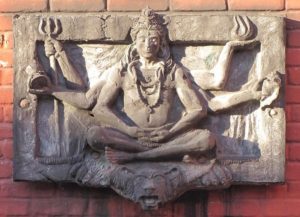
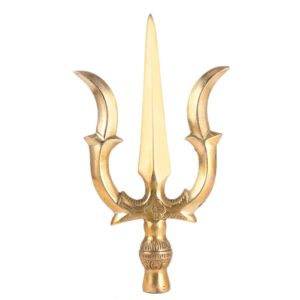
The trident, trishul, created by Surya, the Sun God, was carved out of matter from the Sun. When Surya married Samjna, the daughter of Vishwakarma, his wife soon became unhappy with married life due to the unbearable heat of her husband, Surya. She complained to Vishwakarma, who agreed to solve the problem. The transcendental architect Vishwakarma devised a means to have excess energy apportioned off of Surya. Surya’s heat was ground off on a grinding machine; the solar matter fell to the earth, reducing his heat by 1⁄8th, which was then fashioned into the deadly trishul.
When a trident is used, to spear a fish for example, the trident is inverted, pointing down, just as the gotoku futaoki is inverted to hold the kama lid.
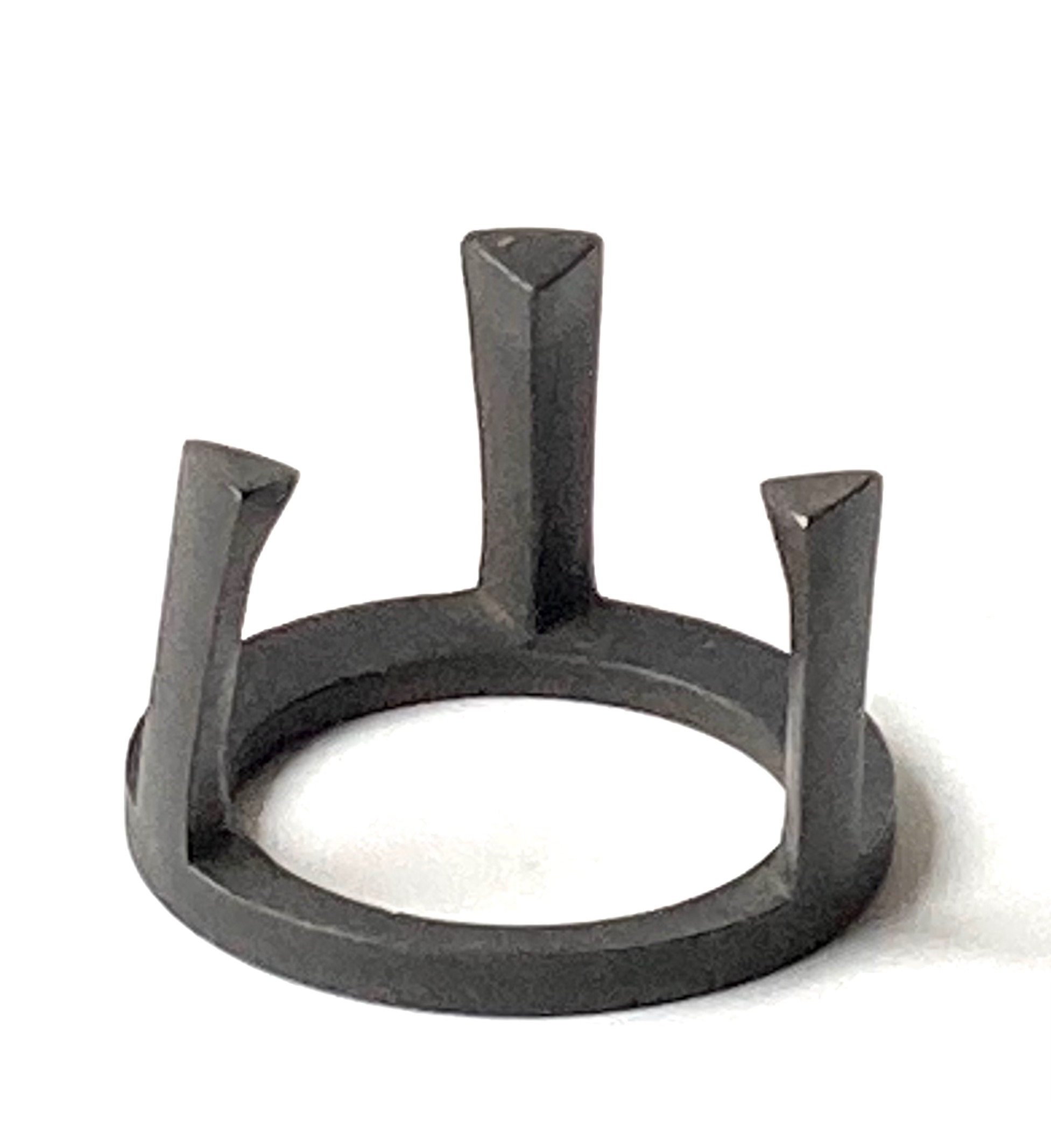
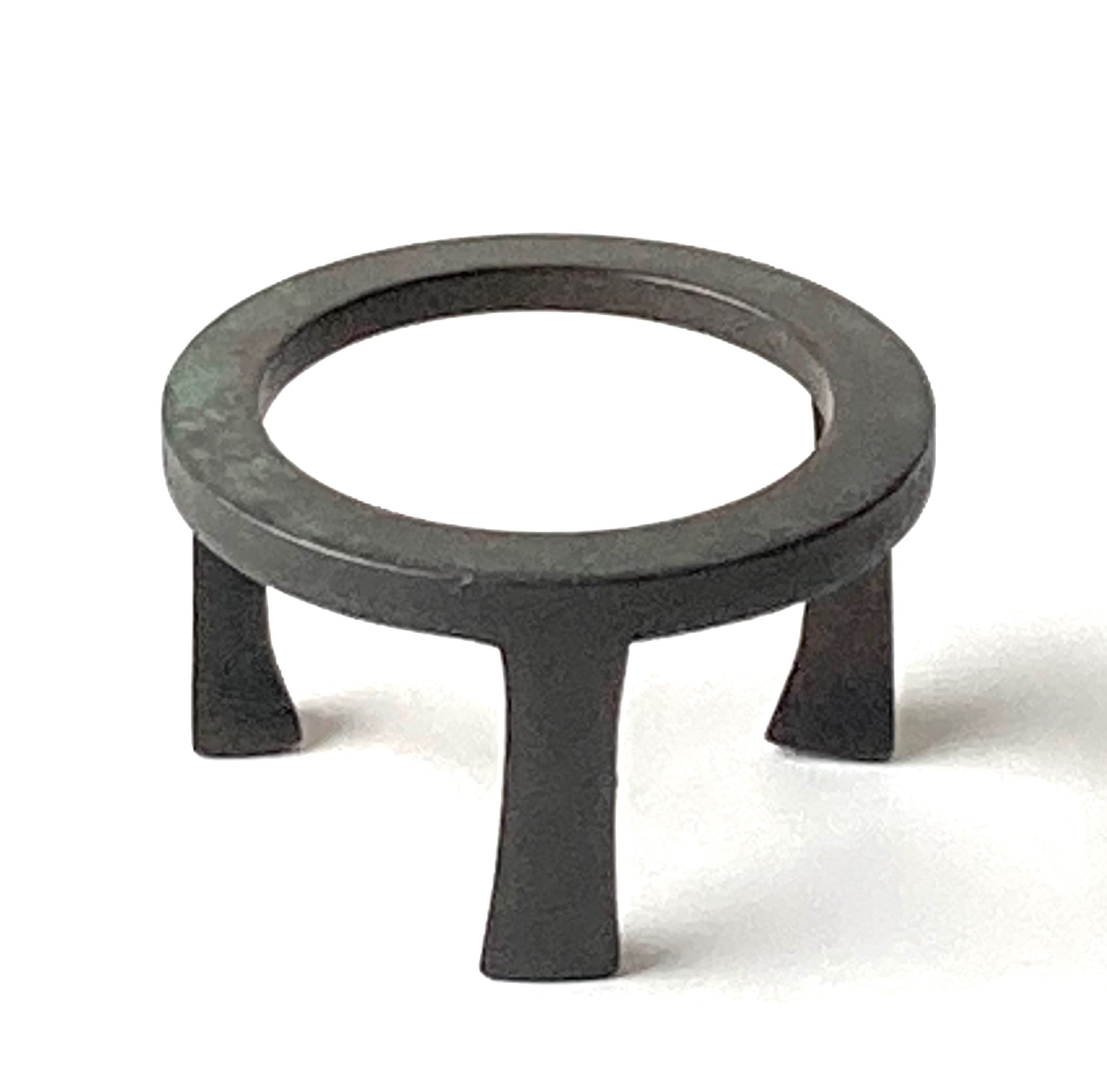
Left: go-toku, 五徳, five-virtues, bronze. Right: gotoku inverted used as a futa-oki, 蓋置, lid-place.
For further study, see also: April: Bells and Kuzu, April and Uzuki, Sekimori Ishi and Ganesha, Tea in April, Tokonoma and Imae, Chashaku and Taishakuten

